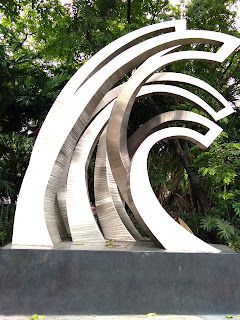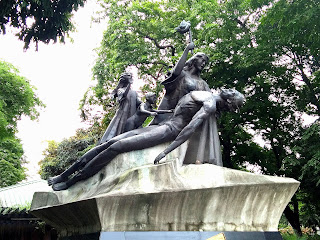Luneta is the pride of Manila, Philippines. Popularlyknown to Filipinos as "pasyalan ng mga taga probinsya" (a place frequented by people from the province). Which still hold true to this day. It's also been known to be "pasyalan ng mga kasambahay pag Linggo" (house-help hangout on Sundays). Yes, it has a bad connotation to it 😛
One can still have a good stroll in Luneta "ng walang pera" (without any cash), as the song goes.

Photographers
Despite the fact that almost everyone now a days has cameras on their phone, these photographers still exist. And they are more in numbers than ever.

If you plan to sit a while in the park but forgot to bring some ground mat. Don't worry, this woman got you covered.

Bring your pet or pet some astray cats in the park.



Spreading the Word of God is not limited to churches. Luneta has several preachers simultaneously preaching at passers-by.

Perfect place to catch up with the news.

Perfect place to take selfies.

Perfect for romance.

If there's romance, there are roses' vendors.

A chocho train is providing everyone a round about tour. P50 to enjoy around the park.

And the nightly musical dancing fountain to cap your day visit.



Since this park is very historical, let me throw some tidbits on its history:
1601 - New Town or Bagumbayan is what its called then. On a side note: The Black Nazarene was originally in the church of Bagumbayan. It was then transferred to San Nicolas de Tolentino then to Quiapo Church. This is why the Translacion always start at Rizal Park.
1874 - became Paseo de la Luneta. Luneta means a crescent moon.
1823 to 1897 - Luneta was notorious for public executions during the Spanish rule. A total of 158 political enemies of Spain were executed. Most notably were the Gomburza and ofcourse, Jose Rizal.
December 30, 1913 - during Rizal’s 17th death anniversary, his national shrine was unveiled. A monument enshrining his remains that serves as the park's symbolic focal point.
December 19, 1955 - it was declared as the nation's national park.
Independence Flagpole is the highest flagpole in the Philippines at 150 feet.

The National Museum of Anthropology and Natural History.



Stickfighting duels are still practice today. An old tradition in Luneta.

Filipino-Korean Soldier Monument is dedicated to the Filipino soldiers who fought with the Korean troops during the Korean War.

Soul waves is placed in the park by Korea, as a sign of mutual respect.

The Lapu-Lapu Monument was another gift from the people of Korea.


The Gallery of Heroes, are two rows of bust sculpture monuments of historical Philippine Heroes.

La Madre Filipina depicted Filipina motherhood.

Binhi ng Kalayaan. Legacy of a hundred years.

An unnamed sculpture none the less it looks interesting.

Dancing Fountain present a show with waters soaring up to 88 feet.

Kalesas to take you out of Luneta and into nearby places like the CCP. I am hoping that this old tradition will now end due to animal cruelty.

Kilometre Zero serves as the point from which all road distances from Manila are measured.

Have you visited this park lately? Don't forget to go back and visit Luneta if you haven't done so in years!

